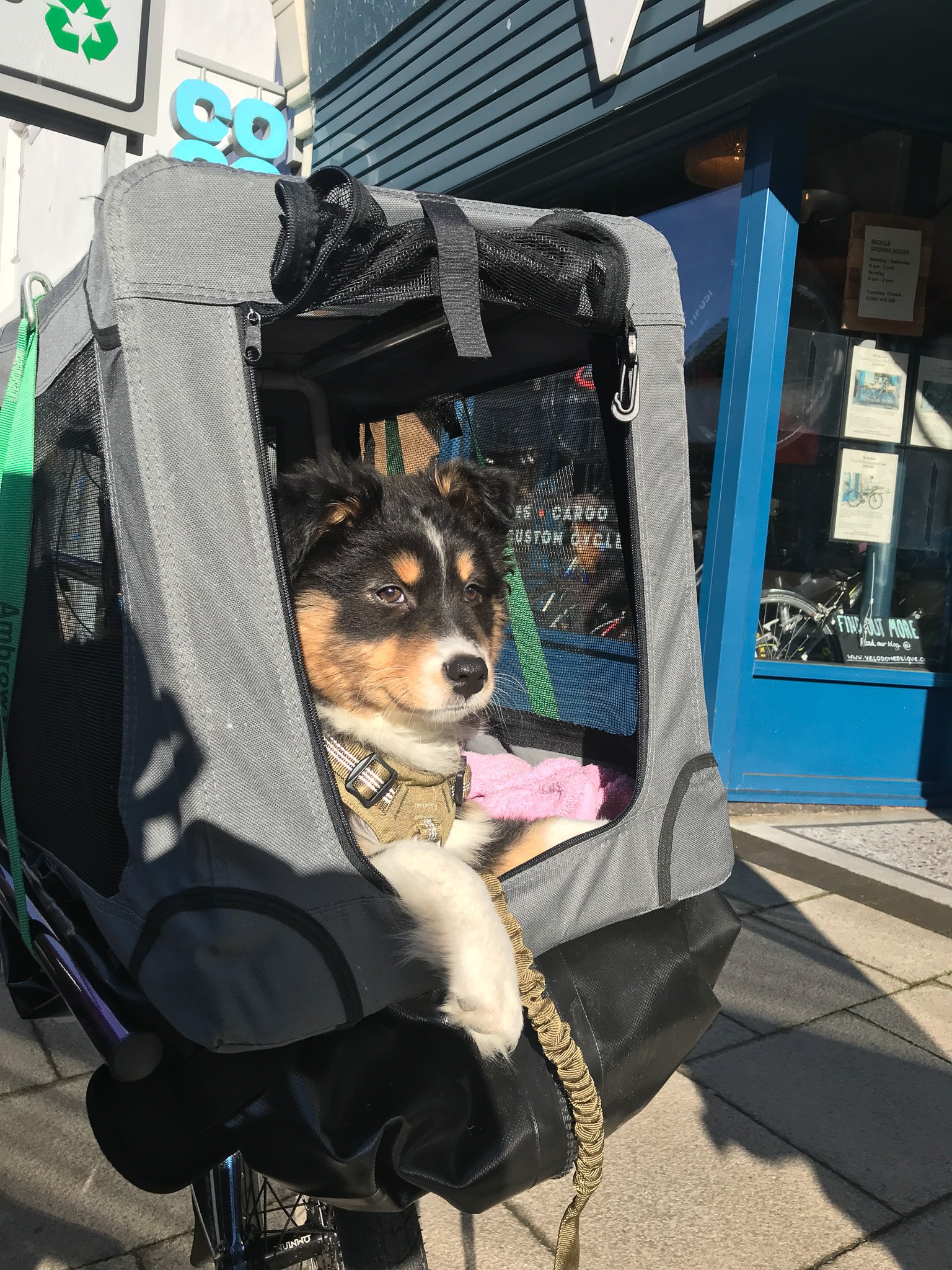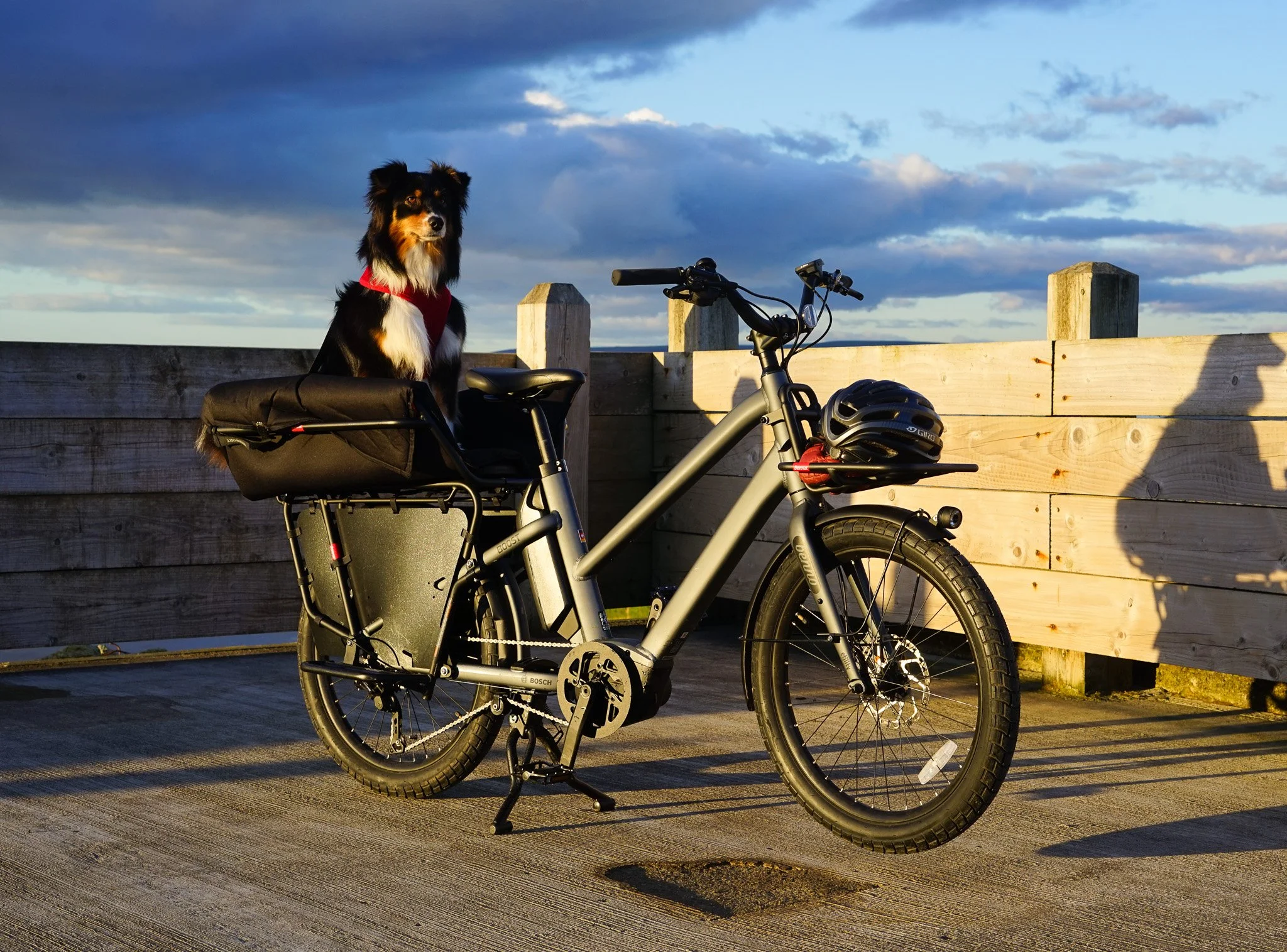7 Tips to Help Train Your Dog to Ride in a Cargo Bike
Carrying your four-legged friends in a cargo bike is a fantastic, efficient way to get them around. When we talk about how great cargo bikes are for moving your precious cargo, we think as much about their canine-carrying capabilities as well as child-carrying capabilities. With that in mind, and the help of our chief cargo dog expert, Tarlo the Australian Shepherd, we've put together 7 tips to help you train your dog to be a cargo bike-loving pup.
1. Start them young
As with any dog behaviour, the sooner you start, the quicker it will become routine for them. Whatever age you start your dog on their cargo bike adventure, make sure you get them acquainted with bikes, specifically cargo bikes, as soon as possible.
2. Train your dog to have a positive association with your cargo bike
If you've got a cargo bike already, try sitting your dog on the rack or cargo area with a bed or something comfortable. We recommend giving them a treat, toy or chew when they settle down or sit in the cargo area. Don't move the bike anywhere to start with; be around them, occasionally rewarding them with encouragement or more treats when they stay on the bike. You can develop this further by having your dog sit or lay on the cargo bike whilst you push it around slowly, constantly praising them, and if you are pushing the bike near a road, make sure your dog is still on a lead.
3. Teach your dog to get onto the cargo bike but not off
Not all dogs are agile enough to hop onto a cargo rack. However, the critical thing here is ensuring they don't think they can jump off. If you are trying to train your dog to jump up onto the rack, even if it's just to put their paws up to start with, we suggest having a command and then tapping the area of the rack you want your dog to jump onto. Follow this up with lots of praise and a treat if they hop up or even put their paws up onto the edge of the rack. In the early stages of getting your dog used to being on the bike, give them plenty of reward and praise for staying up on the rack; the key here is that they associate getting onto the rack and being on the rack with positive reinforcement. Anytime you want to take your dog out of the cargo bike, make sure you stop the bike, ideally put the stand up so that it is stable and then lift your dog out yourself, praising them for being good and staying on the bike. Raising or helping your dog out of the cargo bike teaches them that this is not something they can do on their own. This will massively reduce their likelihood of hopping out whilst you're riding along or stopping at a junction.
4. Bring treats and toys on rides
In the early stages of riding (or even pushing) your cargo bike with your dog is, one of the best ways to make them comfortable with the experience is to keep your dog happy and distracted. We highly recommend a durable chewy treat and take your dog for a ride for the time it takes them to finish the chew. Over time, you should be able to phase out the chew (or toy if toys occupy them) with occasional treats whilst riding, particularly when your dog remains settled and not barking or trying to get out. This will continue to reinforce to your dog that the cargo bike is a great place to be because they get treats and praise, but it will also help them relax into the experience of being pedalled around. We recommend a small handlebar bag or waist bag (bum bag) for easy access to treats whilst riding to keep that positive reinforcement consistent.
5. Practice makes perfect
As with any dog training, repetition is vital; the more you practice a behaviour, the quicker your dog will learn. If you can get one 15-20 minute ride at least once a week with your dog, you will be amazed at how quickly they become used to it. Once your dog has settled into riding a cargo bike, they will visibly grow to love it; the stimulation of smells and sights passing them by is similar to them constantly stuck out of a car window. We found that riding the cargo bike was a fantastic way to tire Tarlo out when she was a puppy and her exercise time was limited. At the other end of a dog's lifespan, we found that with our old dog Rosie, as her ability to go for long walks dropped, the cargo bike allowed us to take her to her favourite walking spots (along the beach) without her having to walk there or get in the car.
6. Choose a rack or cargo area to suit your dog
Some dogs, like Tarlo, really enjoy being up higher, so the Omnium rack setup or the Benno is ideal, particularly with their new foldable cargo boxes. However, larger or less agile dogs may prefer hopping into a Bullitt bike's much lower cargo area. Whichever option you go for, we recommend making it nice and comfy for them, and to start with, consider using a soft dog travel case so your dog feels comfy and can't fall or climb out.
7. Avoid bangs and bumps
Different dogs are alarmed by different things, but whilst your dog is getting used to being a cargo bike passenger, avoiding loud noises or very bumpy surfaces is helpful. When lifting the kickstand of your cargo bike, make sure to be careful it doesn't bang loudly against the frame; if you raise it slowly, it will create less noise and not alarm your dog.
Please tag us on socials in your dogs’ cargo bike adventures using the hashtag #cargodogsofvelo
If you're looking for a cargo bike to carry your furry friend around, get in touch about our range of cargo options, including the Omnium, Bullitt and Benno bike options.
Omnium, Larry vs Harry Bullitt and Benno bikes are our stand-out cargo bikes for carrying dogs, both tried and tested by Tarlo. If you'd like to arrange a test ride of any of our cargo bikes or have any cargo questions, just drop us an email












